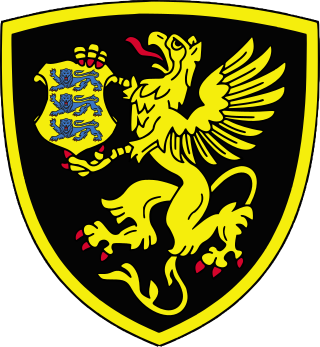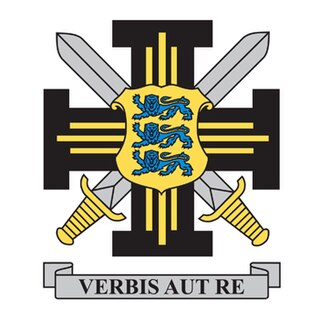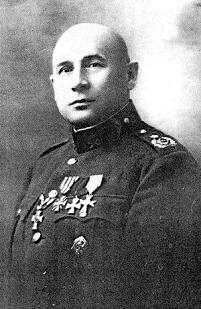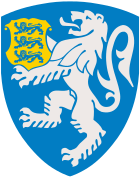Politics in Estonia takes place in a framework of a parliamentary representative democratic republic, whereby the Prime Minister of Estonia is the head of government, and of a multi-party system. Legislative power is vested in the Estonian parliament. Executive power is exercised by the government, which is led by the prime minister. The judiciary is independent of the executive and the legislature. Estonia is a member of the United Nations, the European Union, and NATO.

The Kosovo Police is the national policing law enforcement agency of Kosovo. It was established in 1999 and took its current form with the 2008 police law. It consists of five departments and eight regional directorates and is represented at the political level by the Ministry of Internal Affairs and Public Administration of the Republic of Kosovo.

The Estonian Internal Security Service is a central national security institution of Republic of Estonia. Its purposes are centered on enforcing constitutional order. The Estonian Internal Security Service has primary investigative jurisdiction in some offences committed by state officials; countering terrorism; incitement to hatred; crimes against humanity and peace, including war crimes; illegal handling and trafficking of firearms, ammunition, explosives, radioactive material or other strategic materials; and the protection of state secrets. It also fills counterintelligence duties.

Paldiski is a town and Baltic Sea port located on the Pakri Peninsula in northwestern Estonia. Originally established as a small Swedish port known as Rågervik, it evolved into an important ice-free port upon being incorporated into the Russian Empire in the 18th century.
The Constitution of Estonia is the fundamental law of the Republic of Estonia and establishes the state order as that of a democratic republic where the supreme power is vested in its citizens. The first Constitution was adopted by the freely elected Estonian Constituent Assembly on 15 June 1920 and came into force on 21 December 1920. Heavily amended on 24 January 1934, following a referendum in 1933, it was in force until the second Constitution was enacted on 1 January 1938. It remained in force, de facto, until 16 June 1940, when the Soviet Union occupied Estonia and, de jure, until 28 June 1992, when the third and current Constitution of the Republic of Estonia was adopted by referendum.

15th Artillery Battalion of the 1st Infantry Brigade, formerly the Artillery Group, is an artillery battalion of the Estonian Defence Forces, based out of Tapa Army Base. The unit is part of the Estonian Land Forces. It is tasked with supporting combat units with indirect fire during war-time.

Engineer Battalion is a combat engineering battalion of the Estonian Defence Forces, based out of Tapa Army Base. The unit falls under the command of 1st Infantry Brigade of Estonian Land Forces.

The Ministry of Defence of the Republic of Estonia and its head, the Minister of Defence, are responsible for organizing national defence. It is Estonia's ministry of defence. The mission of the Ministry of Defence is to deter attacks against Estonia and ensure that the country is capable of defending itself against external threats. Estonian national defence is based on initial self-defence capability as well as membership in NATO.

The Estonian Border Guard was the national security agency responsible for the border security of Estonia. It was subordinate to the Ministry of the Interior. The Border Guard also assisted with Search and Rescue missions. In 2010, the organization was superseded by the Police and Border Guard Board.

The Estonian Defence Forces is the unified military force of the Republic of Estonia. The Estonian Defence Forces consists of the Estonian Land Forces, the Estonian Navy, the Estonian Air Force, and the paramilitary Estonian Defence League. The national defence policy aims to guarantee the preservation of the independence and sovereignty of the state and maintain the integrity of its land area, territorial waters, airspace, and constitutional order. Its main goals remain the development and maintenance of a credible capability to defend the nation's vital interests and of the defence forces in a way that ensures their interoperability with the armed forces of NATO and European Union member states in order to participate in the full range of missions for these military alliances.
Estonian Auxiliary Police were Estonian police units that collaborated with the Nazis during World War II.

The Military Police Guard Battalion, or simply Guard Battalion is specialized unit under the Military Police of the Estonian Defence Forces, which conducts ceremonial duties and prepares military police units. It is based in Paldiski and specialized in urban warfare.
Eesti Raadio was the public service radio broadcaster of Estonia that, at the time of closure, operated five national radio stations. It was closed in 2007 as a result of a merger with Eesti Televisioon to form the Estonian Public Broadcasting service, or Eesti Rahvusringhääling (ERR).

The Police and Border Guard Board is a unified national governmental agency within the Estonian Ministry of Interior and is responsible for law enforcement and internal security in the Republic of Estonia.

The Police and Border Guard Aviation Group is a mixed helicopter and airplane flight unit formerly operating under the Estonian Border Guard, but now subordinate to the Police and Border Guard Board. The squadron is a rapid response search and rescue unit, which also conducts medical transport and border patrol operations.

The Military Police of the Estonian Defence Forces is the military police unit of the Estonian Defence Forces. The Estonian military police organization was created in 1994 and its structure includes an investigative department, planning department, logistics department, operational service and the office of the military police. Additionally conscript based reserve- MP platoons are trained every year in Guard Battalion, which is subordinate to the military police. The tasks of the military police include: investigation of serious disciplinary cases and some armed service- related crimes, supervision of military discipline within the Forces, military traffic control and various security tasks. Within conflict/crises areas (Afghanistan) the MP may provide close protection of the Estonian national representative and other visiting VIPs.

Estonian Academy of Security Sciences is a public vocational university in Estonia. It provides professional education for Estonian civil servants under the Estonian Ministry of the Interior. Its objective is to ensure a secure state and stable development, and to contribute to the security of the European Union. It was established on 15 April 1992 and is based in Tallinn. It has facilities in Pärnu County, Väike-Maarja Parish, Narva and Meriküla.

The Directorate of the Ministry of Internal Affairs of Russia for Primorsky Krai, commonly known as the Primorsky Krai Police, is the state police of Primorsky Krai, Russia.

Ants Kurvits or Hans Kurvits was an Estonian military commander, reaching rank of major general. He participated in the Estonian War of Independence and later became the founder and long-time leader of the Estonian Border Guard. Kurvits also served briefly as Minister of War.
The Estonian Foreign Intelligence Service is the foreign intelligence service of Estonia. The Foreign Intelligence Service coordinates with all Estonian intelligence functions, collects intelligence concerning foreign interests and activities, and transmits information to the President, Prime Minister, the General Staff of the Estonian Defence Forces, the Interior Minister, the Foreign Minister, and the Minister of Defence.

















